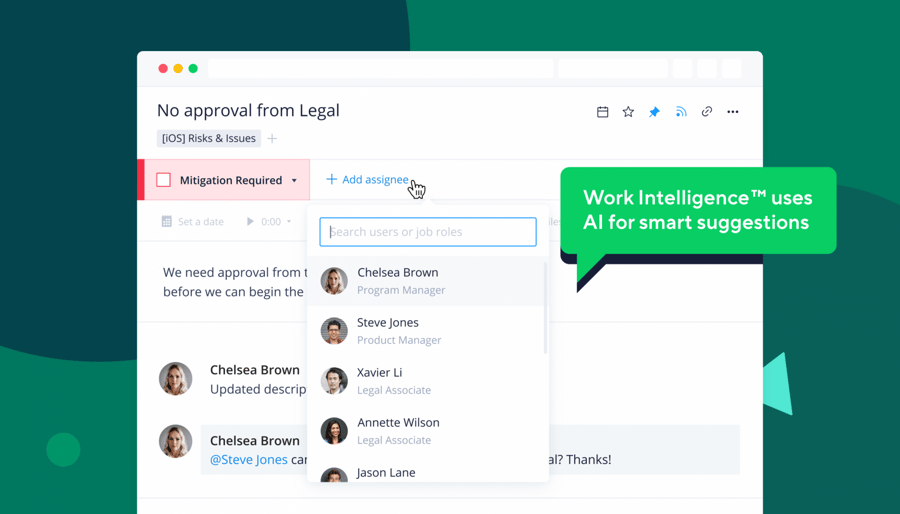I’ll be the first to admit that I raised a skeptical eyebrow when I first saw friends and acquaintances singing the praises of the brand new ChatGPT function. As a writer, I wasn’t too thrilled to see the internet jump up and down about a tool that could seemingly whip up articles and essays in the time it would take me to write a blog title, despite my two decades of training and practicing.
That said, if working for Wrike for the last few years has taught me anything, it’s that AI can help you automate the worst parts of your job so you can focus on the work that matters most.
With that in mind, I dove into the world of ChatGPT in the hopes of learning just how it could help my work as a writer. Here’s what I learned, and how ChatGPT might be able to help you in your own role.
What is ChatGPT?
ChatGPT is an AI chatbot developed by the company OpenAI and released to the public in November of 2022. By typing a question or a prompt into ChatGPT, the AI chatbot can generate answers to complex questions, spit out outlines for term papers, and write song lyrics, poetry, and even code. It can make recommendations for recipes based on a set of ingredients and offer travel suggestions for an upcoming trip.
Rather than typing a question into a search engine like Google and receiving hundreds of results you have to sift through, ChatGPT does that sifting for you — for better or for worse. Based on your parameters, ChatGPT predicts what answer is best and gives you results in seconds.
ChatGPT also responds conversationally to your queries, making it an altogether different experience than using a simple search engine.
How does ChatGPT work?
As a writer, I find it helpful to have a basic understanding of how important AI models that might threaten my livelihood (insert nervous chuckle). Essentially, ChatGPT is a type of AI that has been trained and honed by humans.
ChatGPT stands for generative pre-trained transformer, which is a group of language models that draw on a large body of text to create human-like responses. In the case of ChatGPT, the AI has been trained by humans using a reward system. Essentially, humans train ChatGPT how to respond in particular situations, and the AI learns from those examples.
It’s important to remember that ChatGPT and other language models aren’t sentient, no matter how clued in they may seem. However, they can pull information from a huge pool of data and make a decision about what you’re most likely to want based on their human training.
What can ChatGPT do?
The list of tasks ChatGPT can attempt to help you with is almost infinite, since it pulls from the breadth of what the internet has to offer. Here are just a few examples of things ChatGPT can do to help a writer’s daily work.
- Check grammar: Looking for a quick grammar check before you send an email or publish an eBook? ChatGPT can give you a dig-out. However, it’s not 100% reliable, can’t give you the kind of feedback a human editor would, and can sometimes insert new grammar issues you might not notice.
- Get a quick understanding of a topic for background: When you need a very basic understanding of a complex or new-to-you topic, you can ask ChatGPT to give you a run-down. You’ll still want to do your own research (more on that below), but ChatGPT can break a complex problem into digestible paragraphs so you can begin to comprehend something you otherwise had no knowledge of previously.
- Find a starting point for long-form work: As a writer, sometimes the hardest thing to do when faced with an assignment or task is to start. A blank page can be really intimidating! You could ask ChatGPT to produce an outline for a white paper or topic points for a blog post, and that would give you some momentum toward accomplishing the task.
Those could be very helpful elements in terms of a writer’s daily work, so long as you understand the limitations that ChatGPT faces. Let’s look into those a bit more deeply.
What are the drawbacks of ChatGPT?
When ChatGPT first launched, it seemed like high school students were going to be able to ask it to write papers, marketing departments could use it to write lengths of copy, and humans were well on their way to being replaced by AI. Upon further investigation and a lot of trial and error, it seems that’s not the case. My job as a copywriter for Wrike isn’t under threat as I had feared!
That’s because ChatGPT still can’t do what humans can do. It may be trained by humans, but it has significant limitations that will give you pause if you were planning to use it instead of marketing professionals.
- Prone to inaccuracy: Unfortunately, one of the biggest drawbacks of ChatGPT is that it simply makes up information. You will still have to do your own research and draw your own conclusions. ChatGPT just gives you a head start in that process and can give you resources it thinks are most likely to be useful, but it shouldn’t be relied on as factually accurate. In fact, OpenAI, the parent company of ChatGPT, expressed this limitation on its own site: “ChatGPT sometimes writes plausible-sounding but incorrect or nonsensical answers.”
- Requires additional editing: From my perspective as a writer, using ChatGPT requires more time editing than a piece would have taken me to write in the first place. Even if you’re just having ChatGPT write a few paragraphs of an introduction for a blog post, it will need heavy editing to account for the right tone and information accuracy you need.
- Includes inherent biases: Unfortunately, another limitation of ChatGPT is that it can include racial and gender biases perpetuated by the training it is based upon. Because ChatGPT is based largely upon guessing or assuming what answer a user wants, and on the training it receives, it can make discriminatory assumptions that lead to potentially harmful answers. When you’re writing about sensitive subjects, it’s important to take this into account.
There’s an understandable fear among many employees that technology might make their roles obsolete or redundant, but at least with ChatGPT, that’s not likely to be the case. Instead, it’s more likely that people who know how to use AI and technology to their advantage will replace certain current roles. That makes it all the more important to focus on the ways AI can augment our roles and improve our processes.
I know I’m not going to be replacing my daily processes as a copywriter with ChatGPT any time soon, but there are certainly ways I can use it to bolster and streamline more cumbersome processes. The next time I’m feeling writer’s block coming on, I might dip into ChatGPT to get inspiration or a few building blocks I can work with.
And while you may not be able to replace major pieces of your own work with ChatGPT, it’s an important development to keep apprised of as we enter the new era of AI.
Thanks for your interest in our eBook!
Download it nowWe have also sent the eBook link to your email for your convenience.







